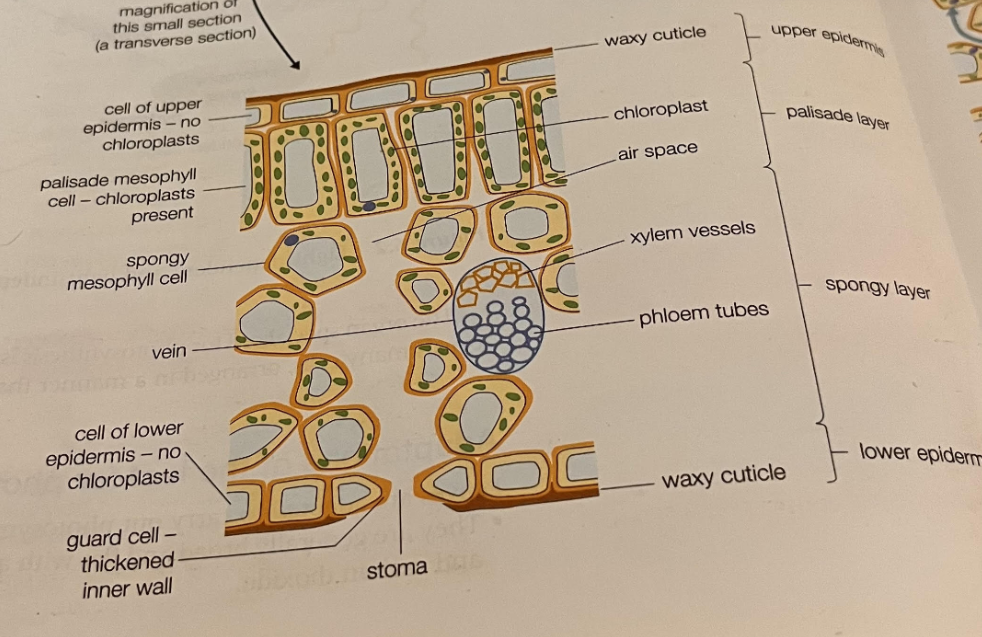BIOLOGY EXAM
ECOLOGY
Definition
The study of living things and their environment.
Why is the Sun the Ultimate Source of Energy?
Plants use the sun’s energy to make food during photosynthesis. Carbon dioxide is combined with water to produce glucose and oxygen.
Glucose is used to make other carbohydrates, lipids, proteins, and everything else the plant needs. These become the components of food. Food can be used for the term ‘energy’.
Energy Gains & Loss
How Plants Gain and Lose Energy
Plants gain energy when they convert the light energy from the sun to chemical energy (food and other chemicals) during photosynthesis.
It stores some of the energy by changing the glucose it makes into other chemicals.
It uses up some of the food during respiration to release energy to grow and carry out other life processes.
Some of the energy is lost as heat energy from the plant.
ONLY SOME OF THE ENERGY TAKEN UP BY THE PLANT CAN BE PASSED ON TO A HERBIVORE.
How Animals Gain and Lose Energy
Energy is gained as the organism feeds
Some of the energy is stored as tissue as the animal grows
Some of the energy is lost as faces and urine from the animal’s body
Some of the stored energy is released during respiration by animals
Some of the energy is lost as heat to the environment.
As little as 10 percent of the energy at any trophic level is transferred to the next level; the rest is lost largely through metabolic processes as heat.
Bioaccumulation
Pesticides can spread through the environment in a food chain. Pesticides (fungicides, herbicides, and insecticides) are chemicals that are toxic to some organisms.
Pesticides can harm organisms in two ways:
On contact
The chemical enters the body of the organism
Symbiotic Relationships
Symbiosis
Any long-term interaction between two different biological organisms
Types of Symbiotic Relationships
Commensalism
A relationship between two different species in which one benefits and the other is not harmed.
Mutualism
Two organisms of different species live closely together, both benefit.
Parasitism
An organism (parasite) feeds on another organism (host), harming the host.
Food Webs & Chains
Food Chain vs Web
Food Chain
A linear sequence of organisms through which nutrients and energy pass as one organism eats another.
In a food chain, each organism occupies a different trophic level, defined by how many energy transfers separate it from the basic input of the chain.
Food Web
Consists of many interconnected food chains and are more realistic representation of consumption relationships in ecosystems.
Energy transfer between trophic levels is inefficient—with a typical efficiency of around 10%. This inefficiency limits the length of food chains.
Adaptations in Predators
Speed
Agility
Weapons (Claws, Fangs)
Ambush Tactics (camouflage)
Adaptations in Prey
Excellent vision
High speed
Camouflage
Defence
Producers & Consumers
Producer
Organisms that produce their own food using energy from sunlight (photosynthesis) or chemicals (chemosynthesis).
Consumer
Organisms that obtain energy by consuming other organisms or organic matter.
Primary Consumer
Herbivores that consume producers (plants or algae).
Secondary Consumer
Carnivores that eat primary consumers (herbivores).
Tertiary Consumer
Predators that feed on secondary consumers.
Trophic Levels
Positions in the food chain or web that indicate an organism's feeding status and energy source.
There are max four trophic levels because of the transfer of energy and nutrients in ecosystems. As energy is transferred between trophic levels, there is a loss of energy efficiency. By the time energy reaches the tertiary consumer level, there is often not enough energy left to support another level of consumers. Therefore, ecosystems typically sustain themselves with up to four trophic levels to efficiently transfer energy from producers to top predators while maintaining ecological balance.
Heterotrophs
Organisms that cannot produce their own food and rely on consuming other organisms for energy.
Autotrophs
Organisms that can produce their own food through photosynthesis or chemosynthesis.
Niche
The specific role or function of an organism within its ecosystem
OSMOSIS
Definition
The diffusion of water molecules from an area where they are in high concentration to an area where they are in low concentration through a partially permeable membrane.
Types of Solutions
Hypotonic Solution
A solution where the concentration of solutes outside the cell is lower than inside the cell. Animal cells become turgid and burst due to the absence of a cell wall, while plant cells swell and remain turgid due to their cell wall.
Hypertonic Solution
A solution where the concentration of solutes outside the cell is higher than inside the cell. The cell membrane pulls away from the cell wall in a process called plasmolysis. This causes water to move out of the cell, leading to shrinking or shrivelling of the cell (becoming flaccid).
Isotonic Solution
A solution where the concentration of solutes outside the cell equals that inside the cell. There is no net movement of water, so the cell maintains its shape and size.
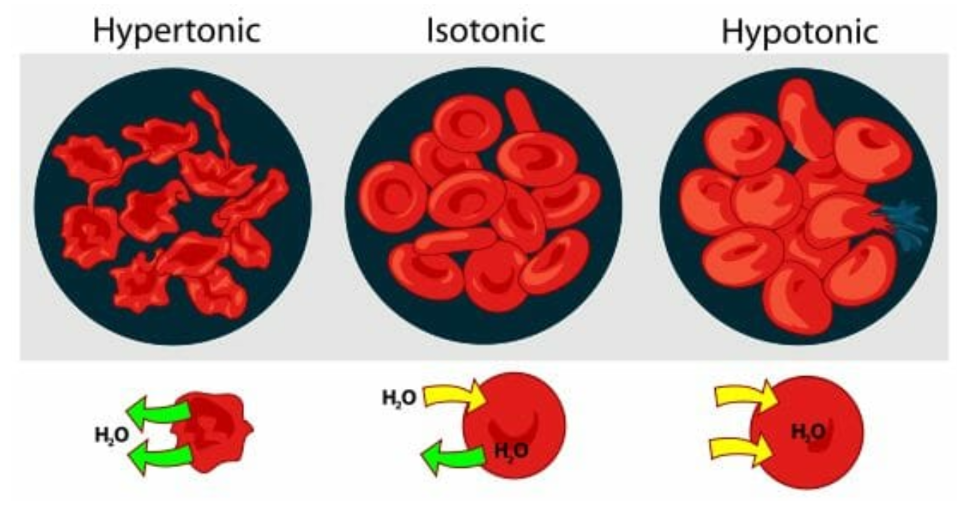
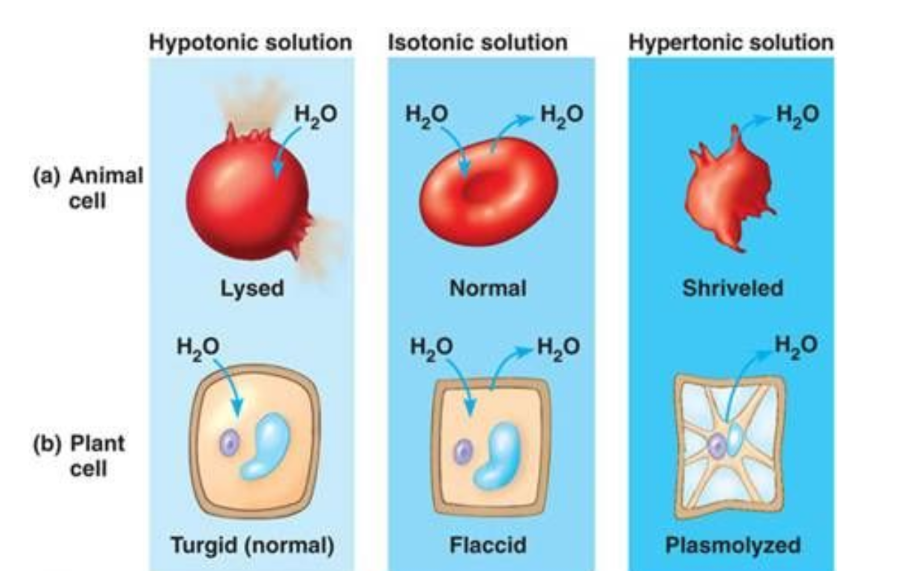
Terms
Plasmolysis
The process in plant cells where the cell membrane pulls away from the cell wall due to water loss, typically occurs in a hypertonic environment.
Flaccid
A plant cell that lacks turgor pressure due to a loss of water. It becomes soft and limp
Turgid
A plant cell that is firm and swollen due to the uptake of water in a hypotonic environment, exerting pressure against the cell wall.
PHOTOSYNTHESIS
Definition
Process whereby green plants make their own food. They use simple inorganic substances ( CARBON DIOXIDE, WATER) to make glucose.
From the glucose, the plants can make other complex materials that it needs such as protein, carbohydrates, and fats.
Photosynthesis Equation
Carbon Dioxide + Water + Sunlight/Chlorophyll —> glucose + oxygen
6 CO2 + 6H2O + sunlight/chlorophyll —> C6H12O6 + 6O2
Importance of Chlorophyll
Chlorophyll is a complex green pigment. At the centre of the chlorophyll molecule is a single atom of magnesium and four atoms of nitrogen.
What Happens to Carbon Dioxide and Water During Photosynthesis
During photosynthesis, carbon dioxide (CO2) and water (H2O) are used by plants to produce glucose (C6H12O6) and oxygen (O2). The process involves the absorption of carbon dioxide from the atmosphere through tiny pores called stomata on the leaves. Water is absorbed from the soil by the roots and transported to the leaves through xylem vessels.
Products of Photosynthesis
The glucose produced during photosynthesis is used in several ways:
It is broken down during respiration to release energy so the plant can carry out all the processes of life.
It is converted to starch and stored in the leaf to be used in the night when the plant is not photosynthesising.
It is converted to sucrose and transported to other parts of the plant. It can be converted to other carbohydrates, lipids and proteins and used for growth, or it can be converted to starch and stored, as in potatoes.
Limiting Factors that affect Photosynthesis
Temperature
Light intensity
Carbon dioxide concentration
Availability of water
Light Stages
Light Dependent Stage
This happens in the thylakoid of the chloroplast.
Chloroplasts are organelles seen in green plant cells. They contain the green pigment chlorophyll which traps the light energy from the sun.
This energy can produce two molecules: Adenosine Triphosphate (ATP) and Nicotinamide adenine dinucleotide phosphate (NADH). These molecules are high in energy which in the light-independent stage is used up in the synthesis of glucose.
The energy is used to split the water molecule H2O into hydrogen (h) and oxygen (o). The oxygen is a waste product and diffuses out of the leaf.
Light Independent Stage/Calvin Cycle
Through the use of enzymes, the hydrogen then combines with carbon dioxide (CO2) to make glucose (C6H12O6).
This stage of photosynthesis does not need light and can happen when it is dark.
Nutrition
The process by which organisms obtain and utilize nutrients for growth, maintenance, and energy production.
Autotrophic Nutrition
Making their own food from inorganic substances.
Heterotrophic Nutrition
Obtaining food by consuming other organisms or organic matter.
Types: Holozoic, Saprohytic, Parasitic
Simple Leaf Structure
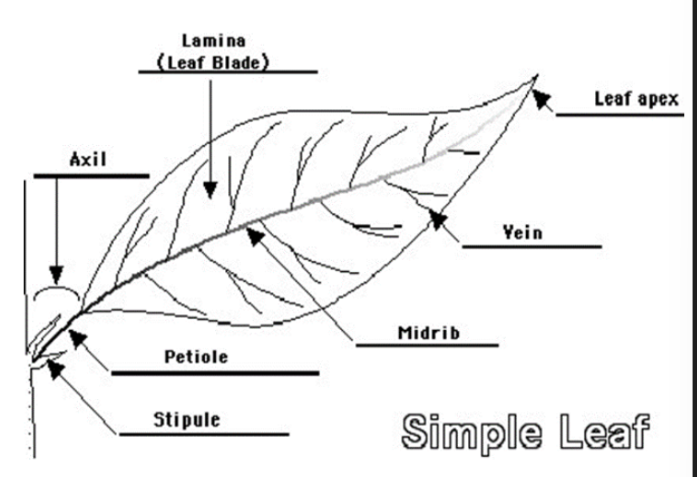
Leaf Adaptations
They are generally broad and flat with a large surface area to absorb a lot of light and carbon dioxide.
They lie at 90 degrees to the sunlight and are spaced around the stem to catch as much light as possible.
The leaves are thin to allow light and carbon dioxide to reach cells rapidly.
Stomata are present in the lower epidermis to allow gases in and out easily.
Air spaces in the lower leaf allow carbon dioxide to get to chloroplasts as quickly as possible.
Chloroplasts are most numerous in cells in the palisade layer which is in the top part of the leaf, closest to the sunlight.
Xylem vessels transport water to the leaf cells.
Phloem sieve tubes carry away the food made to the rest of the plants.
A waxy cuticle prevents water loss from both surfaces of the leaf and is transparent to let light through.
Xylem and Phloem
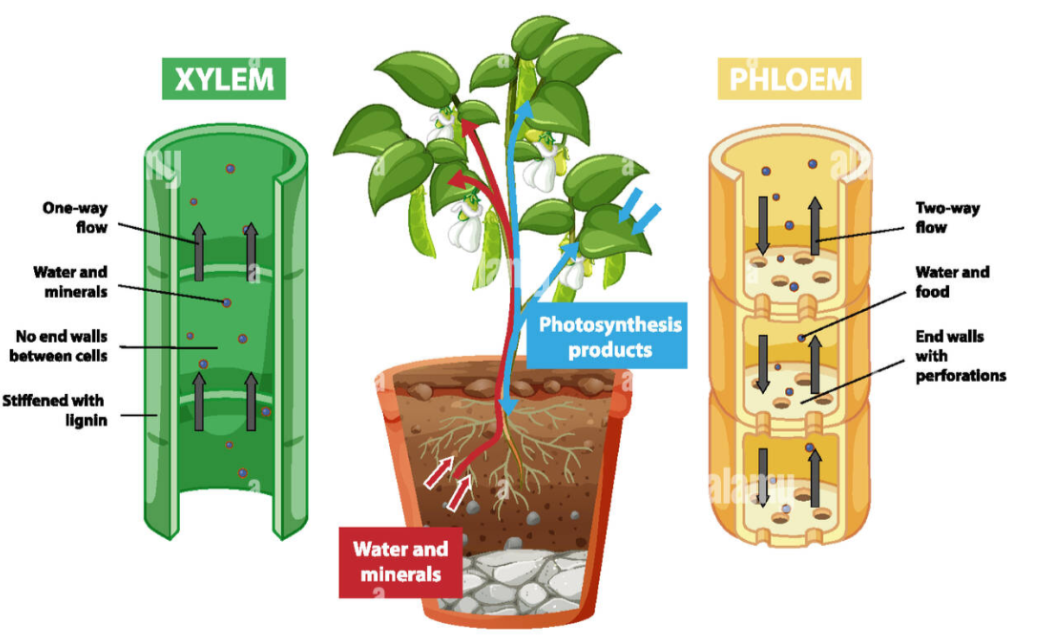
INTERNAL LEAF STRUCTURE
Parts of the Internal Leaf
Epidermis
The top and bottom of the leaf are responsible for protecting the inner layers of cells. The top epidermis secretes a waxy substance called cuticle which prevents water from evaporating from the leaf.
Stomata
Small holes/pores majority of which are found in the lower epidermis. Each stoma is surrounded by a pair of sausage-shaped guard cells. The guard cells are responsible for opening and closing the stoma. They contain chloroplast.
Mesophyll
‘Meso’ means middle, and ‘phyll’ means leaf.
These cells contain chloroplasts. The mesophyll layer located near the top of the leaf is arranged like a fence or palisade and they form the palisade layer. This is where most of the photosynthesis occurs in the leaf. They are closely packed together to maximize light absorption.
The cells behind them are rounder, and arranged quite loosely, with large air spaces between them. They form the spongy layer. The cells in this layer are loosely packed for efficient gas exchange. There is a thin layer of water which covers the cells. Gases dissolve in this water as they move into and out of the cells.
The mesophyll also contains veins. The two are the xylem ( a large thick- walled tube for carrying water & minerals) and phloem tubes (small with thin walls) carry away food that the leaf has made.
STARCH
REFER TO LABS
DIGESTIVE SYSTEM
Terms
Feeding/ingestion
Where food is taken into the body
Digestion
Where large, complex, insoluble food molecules are broken down into smaller, soluble molecules
Absorption
Where small, soluble food molecules are absorbed into the blood and into body cells
Assimilation
Where the food molecules are stored or used by the cells for respiration, growth
Egestion
Where undigested food is removed from the body
Diagram
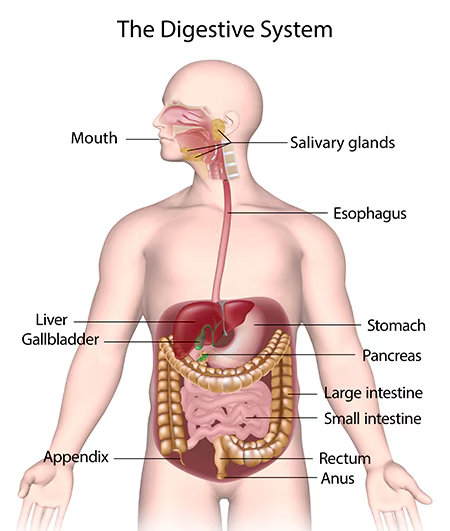
EXAM CRITERIA
SECTION A: 30 MCQ
SECTION B: 2 STRUCTURED (30 MRKS)
TOPICS:
Osmosis
Ecology
Digestive System
Photosynthesis
Starch (Photosynthesis)
Internal Structure of the Leaf (Photosynthesis)
